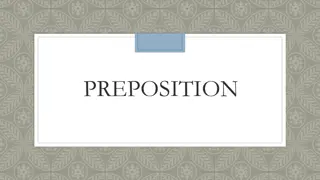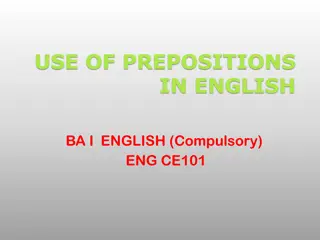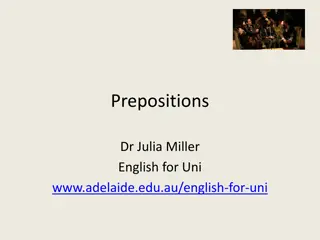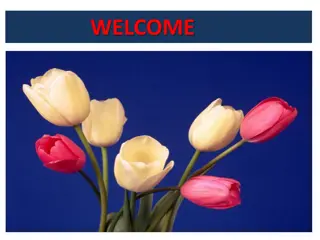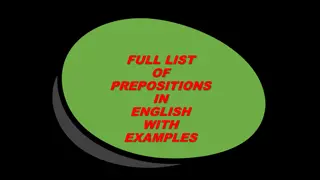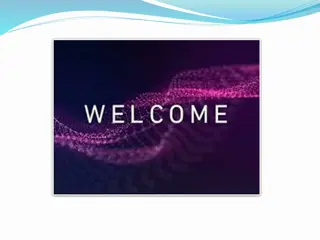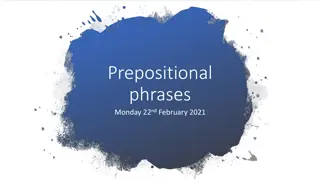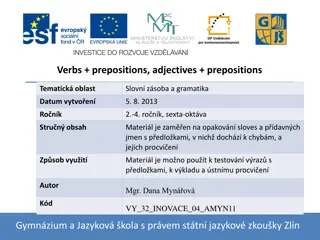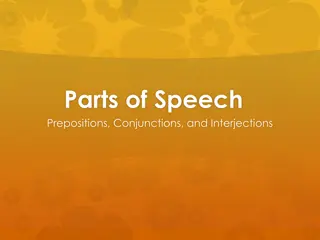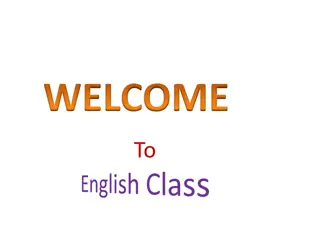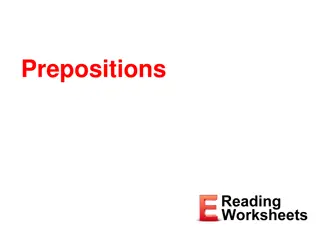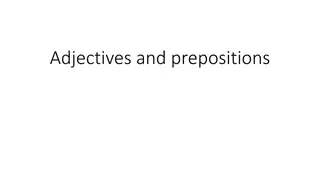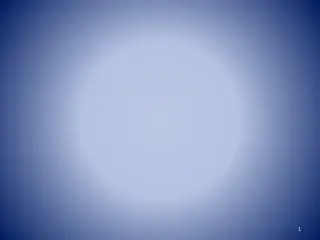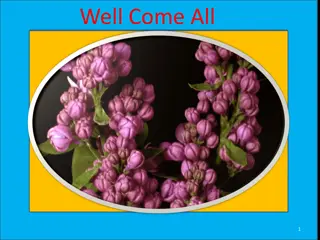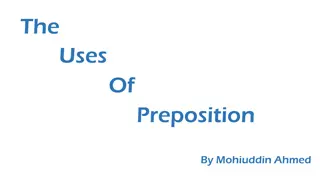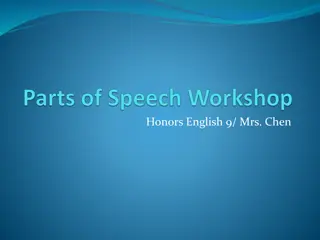PREPOSITIONS
A preposition is a word that establishes the relationship between a noun/pronoun and other words in a sentence. They convey direction, location, time, or manner. Prepositions are crucial for creating prepositional phrases, adding detail and clarity to sentences. Learn about common single-word prepositions, prepositions of movement, abstract meanings of prepositions, and examples illustrating their usage. Enhance your understanding of prepositions in English grammar.
Download Presentation

Please find below an Image/Link to download the presentation.
The content on the website is provided AS IS for your information and personal use only. It may not be sold, licensed, or shared on other websites without obtaining consent from the author. Download presentation by click this link. If you encounter any issues during the download, it is possible that the publisher has removed the file from their server.
E N D
Presentation Transcript
A preposition is a word that shows the relationship between a noun or pronoun and other words in a sentence. It often indicates direction, location, time, or manner. Prepositions are essential in forming prepositional phrases, which help provide more detail and clarity to a sentence. Prepositions are most commonly followed by a noun phrase or pronoun: The last time I saw him he was walking down the road. I ll meet you in the cafe opposite the cinema. It was difficult to sleep during the flight. It was the worst storm since the 1980s. Give that to me. There are over 100 prepositions in English!
The most common single-word prepositions are: about beside near to above between of towards across beyond off under after by on underneath against despite onto unlike along down opposite until among during out up around except outside upon as for over via at from past with before in round within behind inside since like without below into than beneath through
Although most prepositions are single words, some pairs and groups of words operate like single prepositions: They were unable to attend because of the bad weather in Ireland. Jack ll be playing in the team in place of me. In addition to getting a large fine, both brothers were put in prison for three months. I always get nervous when I have to speak in front of an audience. We estimate that there ll be up to 10,000 people at the concert. The most common prepositions that consist of groups of words are: ahead of except for instead of owing to apart from in addition to near to such as as for in front of on account of thanks to as well as in place of on top of up to because of in spite of out of due to inside of outside of
Prepositions and abstract meanings Common prepositions that show relationships of space often have abstract as well as concrete meanings. Compare That map you need is behind the filing cabinet. (basic spatial sense or position) Everyone is behind the government. (behind = gives support) Beyond the hotel were beautiful mountains. (basic spatial sense or position) Learning Chinese in a year was beyond them all. (beyond = too difficult for) Some common prepositions such as at, in and on can have abstract meanings: I think you will both need to discuss the problem in private. All three singers were dressed in black. You now have the next day at leisure and can do whatever you wish. Our dog stays on guard all night, even when he s sleeping!
Prepositions of movement We use prepositions after verbs to describe the direction of movement. It s common to use these prepositions after verbs that describe movement (walk, run, come, go, drive, cycle, fly, etc.), although it is also possible to use them after other types of verbs (We talked over the fence, I looked into the room, etc.) or after nouns (the path to the beach, the road from Leeds, the way up the hill, etc.).
Get on/off the bus or train, get into/out of the car We say get in and get out of for a car, taxi, or van, but we say get on or get off for motorbikes and bicycles and for public means of transport, such as a bus, a train or a plane. I have to get off the bus at the next stop. He stopped and got out of the car. Go to work by car = drive to work When we want to talk about how we go from place A to place B, we can do it in two different ways: Using by + means of transport (car, taxi, plane, bike, etc.) or using on + foot. I go to school on foot. I go to work by car. I went to Zurich by plane. I went to the airport by taxi. Using a verb of movement (walk, drive, fly, cycle, etc.) or for public transport, using take + means of transport. I walk to school I drive to work. I flew to Zurich. I took a taxi/a bus/a train/etc. to the airport.
Adjectives & prepositions dependant prepositions Some adjectives are usually followed by a preposition. These prepositions are called dependant prepositions. Check the list of some of the most common of these prepositions:
Choose the correct prepositions to complete the sentences below 1. We are super excited ___________ the trip. 2. He's famous ____________ his science experiments on YouTube. 3. He is totally different ___________ his brother. 4. You are very bad __________ lying. 5. He isn't capable ___________ taking care of himself. 6. He's obsessed ____________ his new toy. 7. We're very proud ____________ you. 8. How long have you been married _____________ Liam? 9. I'm fed up __________ my new boss. I hate him. 10. I'm not very keen ___________ having to wear a uniform, but I need the job.
Choose the correct prepositions for the following adjectives 1. Katie is very similar in personality ________ her mother. a. to b. at c. of d. With 2. Too much TV is very bad _________ kids. a. with b. in c. for d. About 3. I'm sorry ________ not writing sooner. a. on b. for c. at d. To 4. I'm tired ___________ listening to you. a. in b. at c. about d. of 5. He's very kind ____________ the children. a. with b. to c. about d. of
6. The British are very fond ________ tea. a. of b. about c. with d. to 7. I think he's very angry _________ you. a. with b. of c. to d. for 8. The place was full ___________ people and energy. a. with b. of c. about d. in 9. Chocolate isn't good __________ you. a. for b. with c. to d. at 10. I'm worried _____________ James. He isn't doing well in school. a. with b. of c. about d. to
Fill in each gap with the correct prepositions: at, in, on, of, to, for, about, with. 1. I'm totally hooked ___________ the new series. 2. She's very interested ___________ science. 3. Don't be rude ____________ your father. 4. I'm sorry ____________ what happened last night. 5. The workers are angry ________________ the new measures. 6. She's very close ______________ her mother. 7. We are very pleased _______________ your work. 8. I'm afraid ___________________ heights. 9. I'm totally addicted ________________ caffeine. 10. Alex is very good ______________ solving crossword puzzles.
Choose the correct prepositions to complete the sentences below 1. I ve been waiting ______________ you for more than an hour. 2. I'm looking forward ___________ seeing you. 3. We arrived ______________ the station too late. 4. We are thinking ________________ going on a trip to Venice. 5. Why are you shouting _______________me? 6. This book belongs _____________me. 7. I never complained _______________ my salary. 8. I spent all my money ________________ clothes. 9. He got married ______________ his boss. 10. As soon as we arrived _____________ Lisbon, we called our friends.
Choose the correct prepositions for the following verbs 1. She smiled __________ him, and he blushed. a. to b. at c. on d. of 2. He paid __________ the meal and she paid _________ the taxi. a. to b. for c. - d. of 3. He said ____________ me that I was stupid. a. at b. for c. with d. to 4. He insisted __________ coming with us. a. in b. at c. on d. about 5. We want to invest the money ___________ a big house. a. in b. on c. with d. to
6. She reminds me _________ her mother. a. about b. in c. with d. of 7. I sometimes dream ___________ that trip. a. about b. in c. with d. on 8. Don't try to compare Rome _________ Paris. They're too different. a. with b. of c. about d. at 9. They were laughing _____________ him. a. to b. of c. at d. In 10. I'm going to apply __________ a new job. a. of b. with c. in d. for
Fill in each gap with the correct prepositions: at, in, on, of, to, for, about, with. 1. Do you believe ___________ ghosts? 2. Can I stay _____________ you tonight? 3. She never listens ____________ me. 4. They succeeded _______________ forcing the company to accept the deal. 5. Are you talking ______________ me? 6. You're always arguing ______________ your dad. 7. I'm writing _______________ you because I want to ask you a question. 8. They always argue _______________ money. 9. It depends _______________ the weather. 10. I don't agree ________________you.
Use the correct prepositions of movement to complete the sentences below 1. I flew from San Francisco ____________ Zurich with Swiss International Air Lines. 2. Every morning I get ____________ my bicycle and go to school. 3. The cat was on the table; then it jumped ________________ the table. 4. We got _____________the car and ran _____________ the building. 5. He fell ________________ his motorbike when he was riding very fast. 6. The elevator didn't work and we had to walk ____________ the stairs to the 15th floor. 7. He escaped _______________ a door in the back of the building. 8. We took a boat _________________ the river. 9. The robber broke his leg when he tried to jump ______________ a wall. 10. He took the phone and threw it ________________ the water.
Complete the sentences below using the correct prepositions of movement 1. When he walked ____________ me, he pretended he didn't know me. a. along b. through c. past 2. When he came _____________ the sauna, he was sweating a lot. a. out of b. off c. To 3. Walk _____________ the yellow line to reach the maternity unit. a. over b. into c. along 4. Many people risk their lives to travel ____________ the Mexico-United States border. a. over b. past c. across 5. He threw the ball ________________ the fence and it landed on the roof of a car. a. over b. up c. into
6. Salmons swim _____ rivers to lay their eggs. a. across b. up c. Over 7. I'm coming _____ the hospital. The doctor has prescribed me some pills. a. to b. off c. from 8. He went _____ the room, walked _____ the big table and turned on the TV. a. on/across b. out of/over c. into/around 9. The cat ran _____ the bed to find refuge. a. over b. under c. Into 10. He saw a wasp flying _____ him and ran away. a. towards b. into c. off
Complete each sentence using the appropriate preposition in the box across along from into off out of over to towards through up 1. He jumped from one side of the rock to the other side of the rock. He jumped ____________ the rock. 2. They ran from one side of the street to the other side of the street. They ran ____________ the street. 3. The car was going in the direction of the bridge. The car was going ________________ the bridge. 4. They ran in the trees, from one end to the other end. They ran __________________ the trees. 5. He took a towel and went inside the bathroom. He took a towel and went ___________ the bathroom. 6. We walked following the line of the main street. We walked ______________ the main street. 7. We rode our bikes from a lower position to a higher position on the mountain. We rode our bikes _______________ the mountain. 8. He was on the stage and then he went away from the stage. He went ______________ the stage. 9. When she came from the interior of the office to the exterior of the office, she looked upset. When she came _______________ the office, she looked upset. 10. The place where I'm going to start walking is the gym and my destination is work. I'm going to walk ______________ the gym __________________ work.
Introduction The science of genetics has come a long way since Mendel's laws were rediscovered in 1900. There have been many advances in genetics. One of the most impressive advances was sequencing the human genome. Sequencing the Human Genome A species' genome consists of all of its genetic information. The human genome consists of the complete set of genes in the human organism. It's all the DNA of a human being. The Human Genome Project The Human Genome Project was launched in 1990. It was an international effort to sequence all 3 billion bases in human DNA. Another aim of the project was to identify the more than 20,000 human genes and map their locations on chromosomes. The project brought together experts in many fields. The Human Genome Project was completed in 2003. It was one of the greatest feats of modern science. It provides a complete blueprint for a human being. It's like having a very detailed manual for making a human organism. Applications of the Sequence Knowing the sequence of the human genome is very useful. For example, it helps us understand how humans evolved. Another use is in medicine. It is helping researchers identify and understand genetic disorders. Human Genetic Disorders Sequencing the human genome has increased our knowledge of genetic disorders. Genetic disorders are diseases caused by mutations. Many genetic disorders are caused by mutations in a single gene. Others are caused by abnormal numbers of chromosomes
Disorders Caused by Single Gene Mutations The table below lists some genetic disorders caused by mutations in just one gene. It includes autosomal and X-linked disorders. It also includes dominant and recessive disorders. Examples of human genetic disorders caused by single gene mutations: Genetic Disorder Effect of Mutation Signs of the Disorder Type of Trait Defective protein in tissues such as cartilage and bone Heart and bone defects; unusually long limbs Autosomal dominant Marfan syndrome Unusually thick mucus that clogs airways in lungs and ducts in other organs Defective protein needed to make mucus Cystic fibrosis Autosomal recessive Defective hemoglobin protein that is needed to transport oxygen in red blood cells Sickle-shaped red blood cells that block blood vessels and interrupt blood flow Sickle Cell Anemia Autosomal recessive Reduced activity of a protein needed for blood to clot Excessive bleeding that is difficult to control Hemophilia A X-linked recessive
Relatively few genetic disorders are caused by dominant alleles. A dominant allele is expressed in everybody who inherits even one copy of it. If it causes a serious disorder, affected people may die young and fail to reproduce. They won't pass the allele to the next generation. As a result, the allele may die out of the population. One of the exceptions is Marfan syndrome. Recessive disorders are more common than dominant ones. Why? A recessive allele is not expressed in heterozygotes. These people are called carriers. They don't have the genetic disorder but they carry the recessive allele. They can also pass this allele to their offspring. A recessive allele is more likely than a dominant allele to pass to the next generation rather than die out. Chromosomal Disorders In the process of meiosis, paired chromosomes normally separate from each other. They end up in different gametes. Sometimes, however, errors occur. The paired chromosomes fail to separate. When this happens, some gametes get an extra copy of a chromosome. Other gametes are missing a chromosome. If one of these gametes is fertilized and survives, a chromosomal disorder results.
Disorders caused by abnormal numbers of chromosomes: Genetic Disorder Genotype Phenotypic Effects Developmental delays, distinctive facial appearance and other abnormalities Extra copy (complete or partial) of chromosome 21 Down syndrome One X chromosome and no other sex chromosome (XO) Female with short height and inability to reproduce Turner's syndrome One Y chromosome and two or more X chromosomes (XXY, XXXY) Male with abnormal sexual development and reduced level of male sex hormone Klinefelter's syndrome Biotechnology Treating genetic disorders is one use of biotechnology. Biotechnology is the use of technology to change the genetic makeup of living things for human purposes. It's also called genetic engineering. Besides treating genetic disorders, biotechnology is used to change organisms so they are more useful to people.
Methods in Biotechnology Biotechnology uses a variety of methods, but some are commonly used in many applications. A common method is the polymerase chain reaction. Another common method is gene cloning. The polymerase chain reaction is a way of making copies of a gene. It uses high temperatures and an enzyme to make new DNA molecules. The process keeps cycling to make many copies of a gene. Gene cloning is another way of making copies of a gene. A gene is inserted into the DNA of a bacterial cell. Uses of Biotechnology Biotechnology has many uses. It is especially useful in medicine and agriculture. Biotechnology is used to: - Treat genetic disorders. For example, copies of a normal gene might be inserted into a patient with a defective gene. This is called gene therapy. Ideally, it can cure a genetic disorder. - Create genetically modified organisms (GMOs). Many GMOs are food crops such as corn. Genes are inserted into plants to give them desirable traits. This might be the ability to get by with little water. Or it might be the ability to resist insect pests. The modified plants are likely to be healthier and produce more food. They may also need less pesticide.
- Produce human proteins. Insulin is one example. This protein is needed to treat diabetes. The human insulin gene is inserted into bacteria. The bacteria reproduce rapidly. They can produce large quantities of the human protein. Concerns about Biotechnology Biotechnology has many benefits. Its pros are obvious. It helps solve human problems. However, biotechnology also raises many concerns. For example, some people worry about eating foods that contain GMOs. They wonder if GMOs might cause health problems. Another concern about biotechnology is how it may affect the environment. Negative effects on the environment have already occurred because of some GMOs. For example, corn has been created that has a gene for a pesticide. The corn plants have accidentally cross-pollinated nearby milkweeds. Monarch butterfly larvae depend on milkweeds for food. When they eat milkweeds with the pesticide gene, they are poisoned. This may threaten the survival of the monarch species as well as other species that eat monarchs. Do the benefits of the genetically modified corn outweigh the risks? What do you think?
Write true if the statement is true or false if the statement is false. 1. species evolved. 2. _________ Dominant genetic disorders are more common than recessive genetic disorders. 3. _________ Based on his phenotype, U.S. president Abraham Lincoln is thought to have had Turner s syndrome. 4. _________ Most chromosomal disorders involve the sex chromosomes. 5. _________ Biotechnology is also referred to as genetic engineering. 6. _________ The only use of biotechnology is curing genetic disorders. 7. _________ Eating GMOs has been shown to cause genetic disorders in people. _________ Knowledge of the human genome helps us understand how the human Read this passage based on the text and answer the questions that follow. Biotechnology is the use of technology to change the genetic makeup of living things for human purposes. The purposes might be to treat human diseases or to modify other organisms so they are more useful to people. Biotechnology uses a variety of methods, but some are commonly used in many applications. They include the polymerase chain reaction and gene cloning. Both are used to quickly make many copies of a desired gene. The polymerase chain reaction uses high temperatures and an enzyme to make new DNA molecules. The process keeps cycling to make many copies of a gene. Gene cloning uses bacteria to make new DNA molecules. The desired gene is inserted into the DNA of a bacterial cell. Bacteria multiply very rapidly by binary fission. Each time a bacterial cell divides, the inserted gene is copied.
Biotechnology has many uses. It is especially useful in medicine and agriculture. Biotechnology is used to: Treat genetic disorders. For example, copies of a normal gene might be inserted into a patient with a defective gene. This is called gene therapy. Ideally, it can cure a genetic disorder. Produce human proteins. Insulin is one example. This protein is needed to treat diabetes. The human insulin gene is inserted into bacteria. The bacteria reproduce rapidly so there are soon enough of them to produce large quantities of insulin. Create genetically modified organisms (GMOs). Many GMOs are food crops such as corn. Genes are inserted into plants to give them desirable traits. This might be the ability to get by with little water or to resist insect pests. The modified plants are likely to be healthier and produce more food. They may also need less pesticide. Questions 1. What is biotechnology? 2. Describe the polymerase chain reaction and gene cloning. Why might these techniques be used? 3. Define GMO. Why might GMO crops be able to produce more food than non-GMO crops?
Identify the correct answer. 1. Specific aims of the Human Genome Project include: a. identifying the more than 20,000 human genes b. mapping all human genes on chromosomes c. sequencing the 3 billion bases in human DNA d. all of the above 2. Which type of trait is sickle cell anemia? a. X-linked recessive b. X-linked dominant c. autosomal recessive d. autosomal dominant 3. Chromosomal disorders occur when chromosomes fail to separate normally during a. meiosis b. fertilization c. mitosis d. birth
4. Which disorder is caused by a missing chromosome? a. Turner s syndrome b. Klinefelter s syndrome c. Down syndrome d. all of the above 5. The Human Genome Project was completed in a. 1900 b. 1990 c. 2003 d. 2010 6. An example of an X-linked disorder caused by a mutation in a single gene is a. Hemophilia A b. Turner s syndrome c. Klinefelter s syndrome d. two of the above 7. Why did scientists insert the gene for human insulin into bacteria? a. to cure the bacteria of diabetes b. to make large quantities of insulin c. to better understand diabetes d. to cause mutations in the gene
Match each definition with the correct term. Definitions: 1. _________ method of making copies of a gene that uses bacteria 2. _________ any disease caused by mutations 3. _________ example of a disease caused by a chromosomal mutation 4. _________ example of a disease caused by a dominant mutation 5. _________ method of making copies of a gene that uses heat and an enzyme 6. _________ international effort to determine the complete genetic blueprint of a human being 7. _________ example of a disease caused by a recessive mutation Terms: a. b. c. d. e. f. g. polymerase chain reaction cystic fibrosis gene cloning Marfan syndrome Human Genome Project Down syndrome genetic disorder
Fill in the blank with the appropriate term. 1. 2. 3. for human purposes. 4. The letters __________________stand for an organism that has been artificially modified by receiving genes for desirable traits. 5. A(n) __________________ allele is expressed in every individual who inherits even one copy of it. 6. __________________syndrome is a genetic disorder caused by an extra copy of chromosome 21. 7. Inserting a normal gene into a patient with a defective gene is called __________________therapy. All the genetic information of a species makes up its __________________. A heterozygote for a recessive genetic disorder is called a(n) __________________. __________________is any use of technology to change the genetic makeup of living things Critical Writing Thoroughly answer the question below. Use appropriate academic vocabulary and clear and complete sentences. Do you think food producers should be required to state on food labels whether their foods contain GMOs? Why or why not?


